|
[Ancient Ancestors]
[Coat Colourings]
[Markings]
[Body Building]
[Some Information]
[Activities]
|
Interesting
Facts
The
Equidae Family
|
|
|
As said
in the "Ancient
Ancestors"
section, the Equus is the nowadays horse. Therefore, all
the horse-like animals have descended from the Equus,
they belong to a family of mammals known as
the Equidae. This family includes horses, zebras,
asses, donkeys, and mules.
|
Blind
Loyalty
|
|
|
Most
animals who live in groups live by hierarchy.
It means that their relationship with each other
depends on each animal's rank in the group. In most
cases it means that the leader(s) commands all the
other ranks, and are often the only ones to breed. Animals that
are one rank lower than the leaders only obey
the leaders, and command all the lower ranks. And
so on.
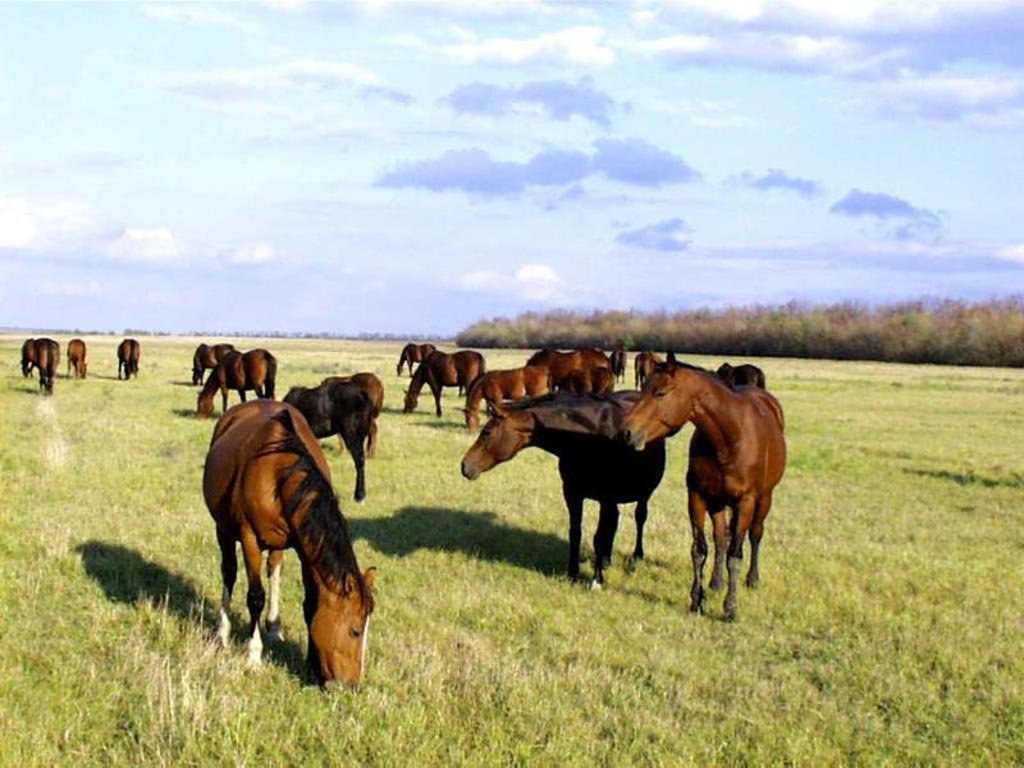
As horses
live in herds as well, this is the reason some of
them obey humans. Any animal whose ancestors live
in groups recognises a human as an animal of its kind of
a higher or lower rank. It is not always easy to influence
an animal's opinion of a man.
|
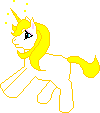
The
Sky Horses
|
|
|
The Lippizanner
is very famous breed of horses. It is named after
the little town of Lippizza, where those horses were
first bred. The breed is particularly famous for
their talent as show horses - the horses who dance.
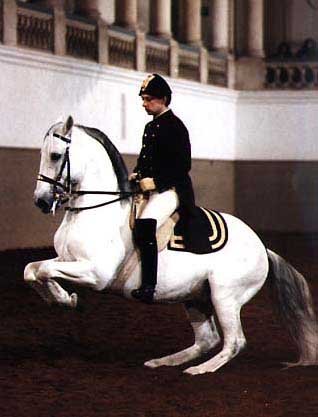
There
are several kinds of dancing they perform - from
walking very beautifully to leaping into the air,
landing and leaping again a few times without having
their forefeet touch the ground. It also includes
the ultimate test of a horse's balance - the Levade. The
horse has to rear up on its hind legs, so that the
hind leg cannon bones are almost horizontal. A horse can
only stay like this for a few seconds. Another trick
is standing on hind legs and spinning around. Training a Lippizanner
takes about ten years. Then, if the horse is talented
enough, the horse is trained the most difficult
movements: they are called "Airs Above the
Ground." This includes the Courbette (jumping
upward with its feet tucked beneath) and the capriole
(leaping forward into the air several times without touching
the ground with its forefeet. See picture below.) Only stallions are
trained or ridden, the mares spent a happy life
grazing, never touched or captured.
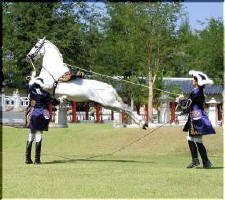
The Lippizanners
were first trained the tricks for military purposes.
The horse would jump upward to give the rider a
better look around, and leap forward to break
through the enemy's line or crash an opponent.
As known
to many professional show horse trainers, usually
the horse can already do the act, and it is just
the matter of making the horse do it on command.
In the wild, a stallion would stand on the hind
legs, performing the Levade, in order to show off
before other horses. Therefore, even the foals do
Caprioles, Levades, Ballotades, and Courbettes,
but while trained stallions do it for show, the
foals do it for amusement.
The Lippizanners
are also very special physically. It takes about
ten years for a Lippizanner foal to mature. Furthermore,
all Lippizanners are born black or chestnut, but
they are completely white by the age of ten. Though
occasionally, a foal is born that stays dark all
its life. One of such foals is often kept in a performing
team for good luck.
|
The
Aristocrats
|
|
|
The Arab
is the oldest registered breed of horses on Earth. It
is more than 2000 years old.
The Arabian people carefully keep the pedigree (family
tree) of each horse recorded, and kept in a
small leather bag which is usually tied around the horse's neck.
The Arabians
are counted among the fastest and toughest horses. Days
of constant riding in the desert with little food
or water, then fighting the enemy tribes with all
might, has made the Arabians horses of great speed,
power, and endurance.
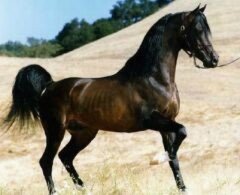
Arabians
are also counted among the most beautiful and graceful
horses. When looking at the beauty of a horse,
Arabian people look at the head first. If it is
wedge shaped, with the muzzle so fine that the horse
can sip tea from a tea-cup, has large antelope's
eyes set wide apart and low in the face, ears turned
outward with
the tips pointing towards each other, then the horse
is of grand quality. A long, arched neck, high carried
tail, and long
legs are also the signs of beauty.
.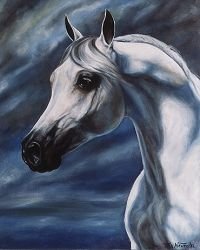
The Arabian
people have no real concern for the colour of the
horse. All colourings occur in Arabs, except patched
and spotted (but dapple-greys are common). The skin underneath the hair is always
black, to be protected from the heat. Another notable
characteristic of the Arabian horse is its small
size. Arabians are nothing like tiny Shetland ponies,
but their size is small compared to other light
breeds.
Arabians
are very valuable horses. In many African countries,
selling your horse is a crime. However, Arabian
horses are now very popular around the world, they
are being bred to other breeds, in order to improve
the other breed. Many breeders' challenge today
is to ensure that there will always be pure-bred
Arabians.
|
The
Thoroughbred
|
|
|
The Thoroughbreds
are born racehorses. Their racing talents are gorgeous.
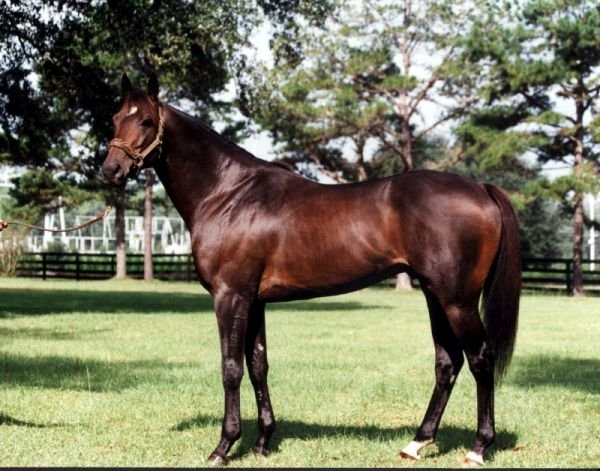
The Thoroughbred
breed started not so long ago. It started with three
Arabian stallions - Byerly Turk, the Darrley Arabian,
and the Godolphin Arabian.
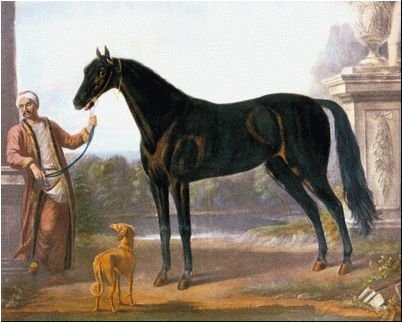
Byerly
Turk
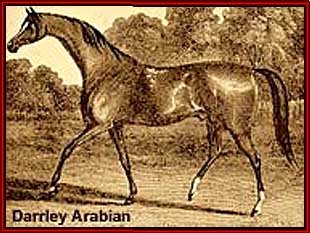
Darrley
Arabian
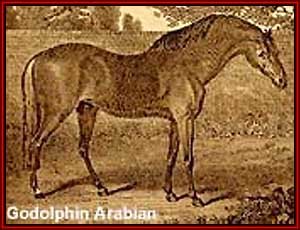
Godolphin
Arabian
These horses were sent to the King of France as
a gift from the Sultan of Morocco. But they arrived
in France in a poor, half starved condition,
as the ship that escorted them to France did not
have enough food for the journey.
The King
of France laughed at the Sultan's advice of improving
the French Barb breed with the mighty sons
of desert, who looked like wretched old nags by
the time they arrived. The horses were sent to do
unmeant jobs - cart pulling, plough pulling, and
others. The Godolphin Arabian was sent to pull a
cart, but was stolen and sold to another person,
who, also, made him a cart horse. A rich man was
looking for a horse for his son to ride, and bought
the poor Arab.
However,
the golden-bay, fiery Arab proved to be an unsuitable riding
horse, and was sold to a horse stud owned by the
Earl of Godolphin, who was looking for a sire to
start a new breed of horses. There, the Godolphin
Arabian was unintentionally bred with a grey Barb
mare named Lady Roxana. She was originally meant for a stallion
Hobgoblin. He was supposed to be the sire to start
a new breed. Both the stallions fell in love with
Lady Roxana, and fought. The Godolphin Arabian won. The Earl of Godolphin, angry with the Arab,
sent him away. But a year after, Lady Roxana gave
birth to a foal, whom the Earl had named Lath. He
was the first son of the Godolphin Arabian.
The Arab was returned, named as he is known today,
and left to sire more horses.
Reading
the book 'King of the Wind' by Marguirite Henry
is recommended for more details.
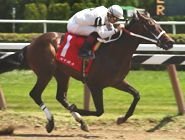
Which
is how the breed of the talented racers began
- the Thoroubreds.
|
|
|
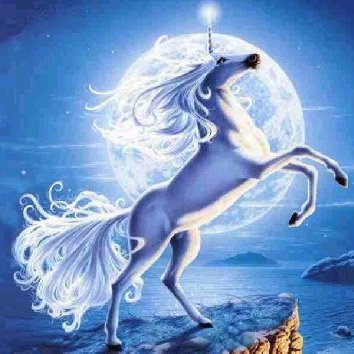
|
|
|
Horses
gave rise to all sorts of different myths and legends.
There is probably no person who haven't heard about
the unicorn - the mythical horse with a horn
growing out of its forehead. In heraldry, this "horse"
had a lion's tail, two-toed hooves, and its horn
was twisted into a spiral. Not to mention the beard
and the feathered feet.
|
|
|
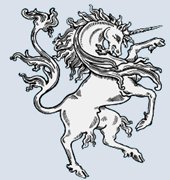
|
|
|
The myth
of centaurs - half-men, half-horses had probably arisen
when the people of ancient Greece had seen the horsemen
of Thessaly. As they were not familiar with horseback
riding, they believed they were seeing a new form
of beings.
|

|
|
|
Legend
has it that when Perseus had killed the Medusa,
Pegasus - the winged horse - had sprung from her
blood. But Athena had managed to tame Pegasus
with a golden bridle.
|
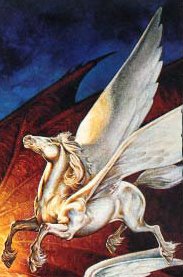
|
|
|
In ancient
Greece, it was believed that a team of four horses
would pull a chariot with the Sun in it across the
sky.
In the
times of the Trojan war, the legendary hero Odysseus
had tricked the Trojans using a wooden horse. When the
Greeks were close to losing the war, Odysseus built
a giant wooden horse out of the wood from wrecked
ships, filled it with soldiers, and
one of his men gave it to the king of Troy as a
gift. The Trojans accepted the gift, and rolled
it into the town, believing that the war was over.
When it was night, the Greeks came out, opened the
gate, and let the rest of the army inside.
Of course,
the imagination of people has also created creatures
like Hippogriffs, men with horse-legs, winged
unicorns, flying centaurs, and some simply beastly
horses.
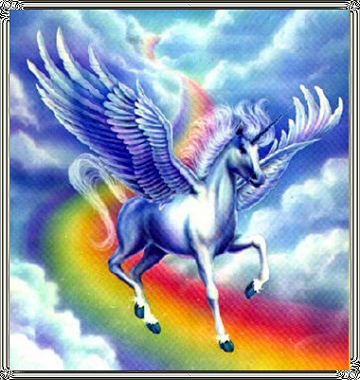
|
Other
Facts & Definitions
|
|
|
Stallion
- an adult male horse
Mare
- an adult female horse
Gelding
- a gelded adult male horse (a horse which had its
reproductive organs removed)
to geld
- to remove a stallion's reproductive organs
Foal
- an immature horse
Colt
- a male immature horse
Filly
- a female immature horse
Dam -
a horse's mother
Sire
- a horse's father
to sire
- a stallion mates a mare, and the mare gives birth
to a foal - the foal is sired by the stallion
Pedigree
- a horse's family tree
Stud
- a farm where horses are bred
Most
horses, except for certain breeds, become physically
mature at the age of four years.
Other
words for horses - steed, charger, nag (old horse),
dam, sire, pack horse, outrunner, stud horse, trooper,
troop-horse, cart-horse, work-horse, draught horse,
wheelhorse.
to gallop
- to run at full speed

to trot
- to run a slow pace, bouncy, slightly faster than a walk
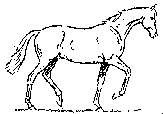
to canter
- to run a slow gallop

to pace
- to run at a fast pace, with the fore left foot
setting out at the same time as the hind left foot,
and same with the right
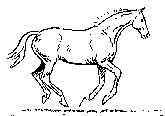
to rear
- to stand on the hind legs

to buck
- to bounce with the withers up and head down
to perform
a Courbette - to jump without touching the ground
with the forefeet
to perform
a Capriole - to leap forward several times without
touching the ground with the forefeet
to perform
a Levade - stand on the hind legs so that the cannon
bone is almost parallel with the ground
|


E-mail
|

